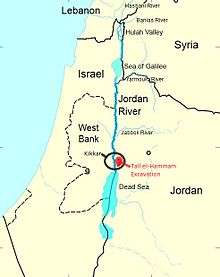Steven Collins (archaeologist)

Steven Collins is an archaeologist and a professor with the College of Archaeology at the unaccredited Trinity Southwest University in Albuquerque, New Mexico, an institution that states that biblical scripture is the "divinely inspired representation of reality given by God to humankind, speaking with absolute authority in all matters upon which it touches".[1] Currently he is the chief archaeologist and co-director of the Tall el-Hammam Excavation Project in Jordan, working with the Department of Antiquities of the Hashemite Kingdom of Jordan. He began the project in Jordan in 2005. His archaeological investigations at Tall el-Hammam, a site in the southern Jordan River valley, that Jews called Eastern Kikkar, where investigators have found the remains of a fortified city that was destroyed circa the 18th and 19th centuries BCE.[2] In the late 2000s, Collins reported that the site was likely to be the location of the biblical city of Sodom. The Tall el-Hammam Excavation Project is located about 14 km NorthEast of the Dead Sea in Jordan, an inhabited area East the Jordan River and either side of Highway 65 in Jordan, just north of the Dead Sea.[3][4][5][6][7]
He has been an archaeologist for 30 years, researching and teaching on Near Eastern archaeology and biblical studies. His work is as a field archaeologist and Bible scholar, working to tie the biblical record to the historical and archaeological evidence. He is the author of many publications and books. His Near Eastern archaeology work in Jordan is the topic of his current book about the location of biblical Sodom. He is also making a documentary film on the topic. Due to his findings he has appeared on US and international television and radio programs. He has also lectured in the US, Europe, Middle East and Africa.[8][9][10][11][12][13][14]
Scholarly achievements
- 2007 "Tall el-Hammam Excavation 2007: Season Two Activity Report." Presented to the Department of Antiquities of Jordan.
- 2006 "Tall el-Hammam Excavation 2006: Season One Activity Report." Presented to the Department of Antiquities of Jordan.
- 2007 "Tall el-Hammam: A Key Witness to the Archaeology and History of the Southern Jordan Valley—Summary, Conclusions, and Recommendations from the 2007 Excavation Season." Paper presented to the Annual Meeting of the American Schools of Oriental Research, and the Annual Meeting of the Near East Archaeological Society.
- 2008 "Tall el-Hammam Excavation 2008: Season Three Activity Report." Presented to the Department of Antiquities of Jordan.
- 2009 "Tall el-Hammam: Key Witness to the Archaeology and History of the Southern Jordan Valley." Lecture presented to the Institute of Archaeology, The Hebrew University, Jerusalem.
- 2010 "The Tall el-Hammam Excavation Project Season Five Activity Report: Excavation, Exploration, and Survey." Presented to the Department of Antiquities of Jordan.[15]
- 2010 (with K. Hamdan and G.A. Byers) "Tall al-Ḥ̣̣ammām: Preliminary Report on Four Seasons of Excavation (2006-2009)," Annual of the Department of Antiquities of Jordan 53: 385-414.
- 2010 "Tall el-Hammam: Data, Interpretations, and Insights from Five Seasons of Excavation, 2206-2010." Paper presented to the 11th Tri-annual International Conference on the History and Archaeology of Jordan, Paris, France.
- Will the Real Pharaoh of the Exodus Please Stand Up! November 9, 2013.
- Tall el-Hammam Excavation Project Field Manual October 10, 2013
- Discovering the City of Sodom: The Fascinating, True Account of the Discovery of the Old Testament's Most Infamous City, by Steven Collins and Latayne C. Scott.
References
- ↑ Doctrinal Position, Trinity Southwest University website, accessed March 10, 2012
- ↑ Tall el-Hammam Excavation Project website
- ↑ "Looking Back; Claims to new Sodom locations are salted with controversy", Christianity Today, April 2008
- ↑ Popular Archaeology, Archaeologists Return to Excavate Possible Site of Biblical Sodom June 06, 2012
- ↑ Popular Archaeology, Archaeologists Excavate Massive Ancient Gateway in Jordan Nov. 23, 2012
- ↑ Bible Archaeology, Tall el-Hammam, by Gary Byers MA, Jan. 12, 2009
- ↑ Find a Dig, Tall el-Hammam, Jordan, January 31 to February 28, 2014
- ↑ trinitysouthwest.com, Trinity Southwest University, Steven Collins Phd
- ↑ rinitysouthwest.com, Trinity Southwest University, Steven Collins, DMin, PhD
- ↑ linkedin.com, Steven Collins Phd
- ↑ Encyclopedia of Christian Education, Volume 3 edited by George Thomas Kurian, Mark A. Lamport, page 1608, May 7, 2015
- ↑ The Popular Handbook of Archaeology and the Bible, By Joseph M. Holden, August 1, 2013
- ↑ The Excavation of Ancient Sodom, by Herb Munson
- ↑ likev.net, Archaeologist Believes He Found The Remains Of Sodom, Findings Back Up Biblical Account Of Fiery Destruction, by Maroan, Oct. 6, 2015
- ↑ tallelhammam.com, Tall el-Hammam Excavation Publications
External links
- THE OFFICIAL WEBSITE OF THE Tall el-Hammam Excavation Project, A SCIENTIFIC ENDEAVOR OF THE College of Archaeology, Trinity Southwest University, UNDER THE AUSPICES OF THE Department of Antiquities of the Hashemite Kingdom of Jordan
- bletravel.com Bible Land Expeditions
- Ministry of Tourism and Antiquities welcome you to the Hashemite Kingdom of Jordan.
- cityofsodom.com, His Book's web site
- TrinitySouthwest.com (official website)
- TSU-edu.us (official website)